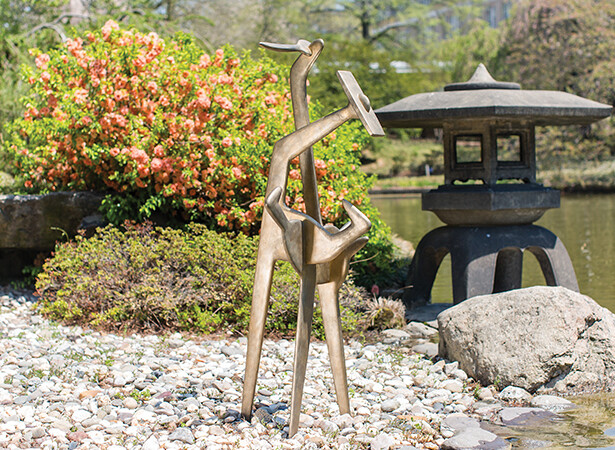September 8–December 13, 2015
Brooklyn Botanic Garden (BBG) is pleased to announce a special fall installation, Isamu Noguchi at Brooklyn Botanic Garden, a presentation of sculptures by the renowned Japanese-American artist. Organized in collaboration with The Noguchi Museum, New York, and curated by the Museum’s senior curator, Dakin Hart, the show includes 18 works by Isamu Noguchi (1904–88) from the Museum’s permanent collection, sited throughout BBG’s outdoor and indoor public gardens. Ranging in date from the mid-1940s to the mid-1980s, the sculptures are on view from September 8 through December 13, 2015.
The centerpiece of the installation includes eight works in BBG’s iconic Japanese Hill-and-Pond Garden. Opened in 1915 and considered the masterpiece of landscape designer Takeo Shiota (1881–1943), this was the first Japanese garden to be created in an American public garden and is one of the oldest and most visited Japanese-inspired gardens outside Japan. Isamu Noguchi at Brooklyn Botanic Garden coincides with the 100th anniversary of BBG’s Japanese Hill-and-Pond Garden and The Noguchi Museum’s 30th anniversary.
Among the works placed in the landscape of the Japanese Hill-and-Pond Garden is Rain Mountain (1982–83). The eight-foot-tall, hot-dipped galvanized steel sculpture is installed just outside the north entrance of the garden, serving as an invitation to explore the gently rolling landscape within. Jack-in-the-Box (1984), a large bronze-plate work reminiscent of the children’s toy, and a paper, bamboo, and metal Akari lamp, model 33X (1968), are sited inside the garden’s viewing pavilion. Strange Bird (1945), a bronze semi-abstract work installed on the turtle island, recalls a pair of bronze crane originally located there when the Japanese garden first opened 100 years ago. Sky Mirror (1970), a low-slung basalt piece with a highly polished surface, is located on the small promontory between the waiting pavilion and the pond, angled to catch the morning light. Here, it embodies one of Noguchi’s most important reference points: the yin-yang relationship between water and stone, seeming opposites—solid/liquid, moving/still—that are in fact intimately related in nature, where they shape each other.
The installation extends to other areas of Brooklyn Botanic Garden as well. Several of Noguchi’s interpretations of rock formations, for example, are installed along the grassy hillsides near BBG’s Rock Garden; other works are displayed in the C.V. Starr Bonsai Museum, the Desert Pavilion, the Osborne Garden, the Plant Family Collection, Cherry Esplanade, the Native Flora Garden, and Ginkgo Allée.
Tour details, an audio tour by Dakin Hart, and more information can be found at www.bbg.org/noguchi.
About Brooklyn Botanic Garden
Founded in 1910, Brooklyn Botanic Garden (BBG) is an urban botanic garden that connects people to the world of plants, fostering delight and curiosity while inspiring an appreciation and sense of stewardship of the environment. Situated on 52 acres in the heart of Brooklyn, the Garden is home to over 14,000 kinds of plants and hosts more than 800,000 visitors annually.
About The Noguchi Museum
The Isamu Noguchi Foundation and Garden Museum opened in 1985 as the first museum in the country to be founded by an artist during his lifetime for the display of his work. The collection and exhibitions focus on Noguchi’s extensive production, articulating the cultural context in which he worked, the many major figures with whom he engaged, and his ongoing influence on the art and design of today. In addition to temporary exhibitions, The Noguchi Museum offers a variety of education and public programs that seek to introduce Noguchi’s work and vision to diverse audiences. These programs encourage the investigation of Noguchi’s work from different vantage points and support participants as they experience the artist’s work from their own perspectives. For more information, please visit www.noguchi.org.


